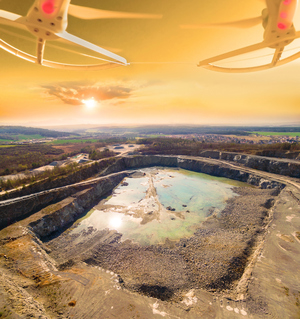The British mathematician and philosopher Alfred North Whitehead pointed out that "civilisation advances by extending the number of important operations which we can perform without thinking about them".
When we imagine the future of mining, we can see that many important operations can be carried out by new technologies to achieve major improvements in performance.
Drones would fly around the site for aerial monitoring/mapping and for transferring items from one place to another. Satellites and sensors would be monitoring and measuring changes to the work environment. Major equipment would be automated through digital twinning and internet of things (IoT) devices. All of these systems would be operated by remote computers, achieving high levels of accuracy, material flow and storage.
Automation is already rapidly changing the face of the mining industry. Technologies such as driverless trucks, autonomous trains, sensors for automatic detection of change collecting data and a suite of other instrumentation are increasingly facilitating real-time monitoring and continuous improvement in mines.
Mine survey functions in both open-pit and underground operations are being increasingly performed by robots and drones, providing incredible precision, quality and resolution in data. These devices can be operated remotely or in a fully automated capacity in many instances. New technologies including artificial intelligence (AI), sensors and automation are being implemented to optimise operations and maintenance across the minerals supply and overall value chain, from mine site to marketing to customer delivery.

Mine survey functions in both open-pit and underground operations are being increasingly performed by robots and drones
We're at the dawn of an exciting future for the resources sector. But, what does this mean for our people? When we think about the future of work in mining, it is not about the technologies - it's about people. Traditional jobs will change significantly with the creation of new and non-traditional jobs and career pathways and a progressive decline in certain roles.
What are the benefits?
The advent of automation and remotely controlled mining means people are moved away from the higher-hazard work areas. Safety will be improved by removing both the exposure of personnel to hazards and the human factors that may cause or contribute to a potential incident. While the mining industry has already achieved tremendous progress in health, safety and environmental performance, automation has the potential to reduce risks even further.
The communities we work in will benefit from the reduced intrusion of our operations on their environment. The new world will also deliver more favourable environmental outcomes, productivity, operating precision, cost reduction and profitability.
Freeing up people (whether in technical or operational roles) from certain mundane, time-consuming, repetitive and boring tasks has great potential to create a more engaged workforce and more satisfying/diverse careers, which can improve morale and increase discretionary efforts.
Mining companies will also have additional higher-quality data to enable further optimisation of designs and utilisation of assets in operations. The analysis and use of extensive and real-time data sets to realise the desired outcomes and improvements is key. How we enable and develop our people to interpret the data for meaningful insights is equally critical to drive performance improvement.
How will the workforce change?
In the fourth industrial revolution, we need to consider how best to attract and retain talent, engage employees and advance the career pathways for our people. Skills like creativity, complex problem-solving and critical thinking are essential for an individual's career and for the company. Lifelong learning is more important than ever, and as employers we need to encourage and enable our people to embrace learning through new and creative ways that use the technologies we now have at our fingertips.
There will be less need for operational and some technical roles, because they will be increasingly automated. The desirable workforce of the future will have strengths in digital literacy, data analytics and interpretation and enhanced supply-chain practices - our emerging talent with a strong history in gaming are well equipped for this new world order.

Ellen Downs
The need for non-technical skills in leadership, particularly engagement, feedback and communication, will be even more acute, given the variability of people's ability to adapt to rapid changes.
The quality of leadership is crucial to how well people buy in to the change and the level of discretionary effort they apply. Leaders will be increasingly expected to reflect high-quality practice at all times with sustaining mechanisms in place for continuous feedback and alignment across organisations. This will not be simply training and workshops but an ongoing practice that supports and celebrates authentic leadership at all levels.
Education will need to change for both technical and non-technical skills. It will need to be flexible in delivery modes along with ongoing development for people already in the mining workforce. For the new technical skills, educators are focused on broader and more generalist science, engineering and business training supplemented by ‘micro-credentials' for specific technical skills.
Universities are already adjusting to the changing demands and industry organisations such as AusIMM are focused on future directions and the links between disciplines and skill diversity.
With fewer jobs on site, how can companies demonstrate ‘social licence to operate'?
Social licence to operate is earned by the company, granted by the community and needs to be well maintained and constantly renewed across the life of the mine.

David Clark
Mining companies must continue to consult with communities earlier. Often communities say they have not been consulted at all until they see the environmental assessment. Earlier inclusion and collaboration will help to proactively solve certain objections or realise common benefits as well as improve relations with community members. By using the latest digital technologies, such as virtual and augmented reality, mining companies can show communities both benefits and impacts of proposed projects earlier in the planning phase.
Proactive use of social media can keep communities more informed and engaged than traditional meetings. Companies can demonstrate public accountability and increased transparency by providing communities with real-time performance data and information with two-way feedback via online tools and social media. This will meet the increased expectation for public disclosure of safety and environmental data (including air, dust or water quality), as well as ground movements experienced within proximity to the public or infrastructure, and how these compare to approved thresholds or targets.
There is a need for higher-level and coordinated advocacy from industry and the representative associations in highlighting to the broader community the significant benefits and importance of mining in general to society, beyond the immediate jobs in operations on site.
As a subset of this, the industry needs to clearly articulate the benefits of new technology and automation. These advocacy efforts need to be coordinated between industry bodies and associations and individual companies who are seen as leaders or major players in the sector.
This piece was originally published by AusIMM Bulletin.
The authors are Dave Clark, group executive manager, GHD Advisory, and director, AusIMM; and Ellen Downs, executive advisor - risk and safety culture services, GHD Advisory.





















INDUSTRY COMMENT
What will the mine of the future be like?
GHD’s Dave Clark and Ellen Downs discuss what increased automation means for mining careers and mining companies’ social licence to operate
"When we think about the future of work in mining, it is not about the technologies – it’s about people."
The British mathematician and philosopher Alfred North Whitehead pointed out that "civilisation advances by extending the number of important operations which we can perform without thinking about them".
When we imagine the future of mining, we can see that many important operations can be carried out by new technologies to achieve major improvements in performance.
Drones would fly around the site for aerial monitoring/mapping and for transferring items from one place to another. Satellites and sensors would be monitoring and measuring changes to the work environment. Major equipment would be automated through digital twinning and internet of things (IoT) devices. All of these systems would be operated by remote computers, achieving high levels of accuracy, material flow and storage.
Automation is already rapidly changing the face of the mining industry. Technologies such as driverless trucks, autonomous trains, sensors for automatic detection of change collecting data and a suite of other instrumentation are increasingly facilitating real-time monitoring and continuous improvement in mines.
Mine survey functions in both open-pit and underground operations are being increasingly performed by robots and drones, providing incredible precision, quality and resolution in data. These devices can be operated remotely or in a fully automated capacity in many instances. New technologies including artificial intelligence (AI), sensors and automation are being implemented to optimise operations and maintenance across the minerals supply and overall value chain, from mine site to marketing to customer delivery.
Mine survey functions in both open-pit and underground operations are being increasingly performed by robots and drones
We're at the dawn of an exciting future for the resources sector. But, what does this mean for our people? When we think about the future of work in mining, it is not about the technologies - it's about people. Traditional jobs will change significantly with the creation of new and non-traditional jobs and career pathways and a progressive decline in certain roles.
What are the benefits?
The advent of automation and remotely controlled mining means people are moved away from the higher-hazard work areas. Safety will be improved by removing both the exposure of personnel to hazards and the human factors that may cause or contribute to a potential incident. While the mining industry has already achieved tremendous progress in health, safety and environmental performance, automation has the potential to reduce risks even further.
The communities we work in will benefit from the reduced intrusion of our operations on their environment. The new world will also deliver more favourable environmental outcomes, productivity, operating precision, cost reduction and profitability.
Freeing up people (whether in technical or operational roles) from certain mundane, time-consuming, repetitive and boring tasks has great potential to create a more engaged workforce and more satisfying/diverse careers, which can improve morale and increase discretionary efforts.
Mining companies will also have additional higher-quality data to enable further optimisation of designs and utilisation of assets in operations. The analysis and use of extensive and real-time data sets to realise the desired outcomes and improvements is key. How we enable and develop our people to interpret the data for meaningful insights is equally critical to drive performance improvement.
How will the workforce change?
In the fourth industrial revolution, we need to consider how best to attract and retain talent, engage employees and advance the career pathways for our people. Skills like creativity, complex problem-solving and critical thinking are essential for an individual's career and for the company. Lifelong learning is more important than ever, and as employers we need to encourage and enable our people to embrace learning through new and creative ways that use the technologies we now have at our fingertips.
There will be less need for operational and some technical roles, because they will be increasingly automated. The desirable workforce of the future will have strengths in digital literacy, data analytics and interpretation and enhanced supply-chain practices - our emerging talent with a strong history in gaming are well equipped for this new world order.
Ellen Downs
The need for non-technical skills in leadership, particularly engagement, feedback and communication, will be even more acute, given the variability of people's ability to adapt to rapid changes.
The quality of leadership is crucial to how well people buy in to the change and the level of discretionary effort they apply. Leaders will be increasingly expected to reflect high-quality practice at all times with sustaining mechanisms in place for continuous feedback and alignment across organisations. This will not be simply training and workshops but an ongoing practice that supports and celebrates authentic leadership at all levels.
Education will need to change for both technical and non-technical skills. It will need to be flexible in delivery modes along with ongoing development for people already in the mining workforce. For the new technical skills, educators are focused on broader and more generalist science, engineering and business training supplemented by ‘micro-credentials' for specific technical skills.
Universities are already adjusting to the changing demands and industry organisations such as AusIMM are focused on future directions and the links between disciplines and skill diversity.
With fewer jobs on site, how can companies demonstrate ‘social licence to operate'?
Social licence to operate is earned by the company, granted by the community and needs to be well maintained and constantly renewed across the life of the mine.
David Clark
Mining companies must continue to consult with communities earlier. Often communities say they have not been consulted at all until they see the environmental assessment. Earlier inclusion and collaboration will help to proactively solve certain objections or realise common benefits as well as improve relations with community members. By using the latest digital technologies, such as virtual and augmented reality, mining companies can show communities both benefits and impacts of proposed projects earlier in the planning phase.
Proactive use of social media can keep communities more informed and engaged than traditional meetings. Companies can demonstrate public accountability and increased transparency by providing communities with real-time performance data and information with two-way feedback via online tools and social media. This will meet the increased expectation for public disclosure of safety and environmental data (including air, dust or water quality), as well as ground movements experienced within proximity to the public or infrastructure, and how these compare to approved thresholds or targets.
There is a need for higher-level and coordinated advocacy from industry and the representative associations in highlighting to the broader community the significant benefits and importance of mining in general to society, beyond the immediate jobs in operations on site.
As a subset of this, the industry needs to clearly articulate the benefits of new technology and automation. These advocacy efforts need to be coordinated between industry bodies and associations and individual companies who are seen as leaders or major players in the sector.
This piece was originally published by AusIMM Bulletin.
The authors are Dave Clark, group executive manager, GHD Advisory, and director, AusIMM; and Ellen Downs, executive advisor - risk and safety culture services, GHD Advisory.
TOPICS:
RELATED ARTICLES
< PREVIOUS ARTICLE
Ideas for a cultural shift in a tech-driven future
NEXT ARTICLE >
Staying in the technology race
Get the Mining Magazine Newsletter delivered free each day
FROM OUR PARTNERS
PARTNER CONTENT
Helping to Bring Order to Tailings Management
PARTNER CONTENT
Michelin 2024: A Sustainable Path to Mining Tyre Design